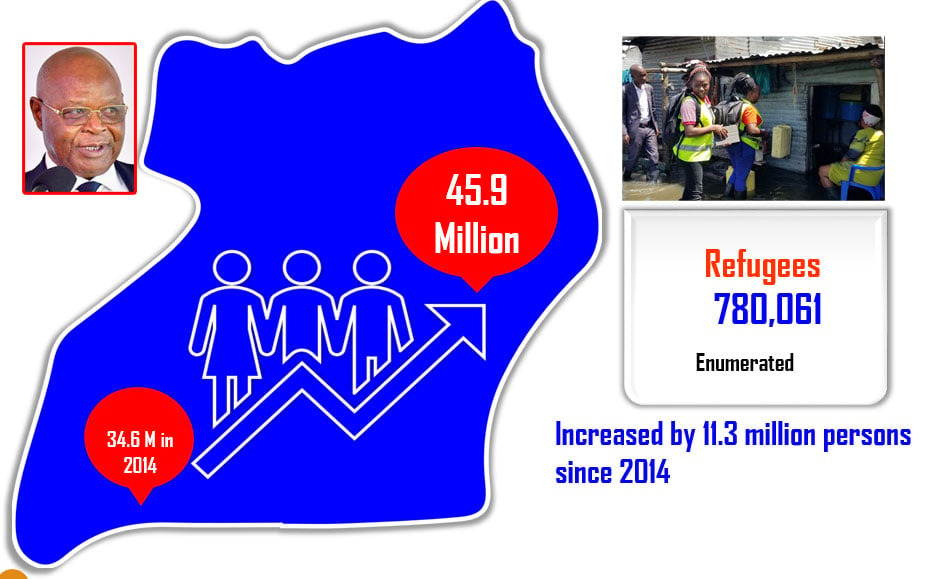Uganda’s population jumps by 11.3 million

Uganda Bureau of Statistics (Ubos) Executive Director Chris Mukiza (right) and board chairperson Albert Byamugisha (left) interact during the release of 2024 national census results yesterday. PHOTO/DAVID LUBOWA
What you need to know:
There is a slight decrease in the growth rate and a notable predominance of young people, according to preliminary census results
Dr Chris Mukiza, the executive director of Uganda Bureau of Statistics (Ubos), released the preliminary results in Kampala yesterday.
The counting of people in the country started on May 10 and ended on May 26. The provisional census results are to be released on September 24, with the final report planned for December 24.
Dr Mukiza said the total population of the country now stands at 45.9 million persons, compared to 34.6 million people at the last count in 2014.
While the population has increased, Ubos reported a decrease in the population growth rate from 3.0 percent in 2014 to 2.9 percent in 2024. The current population was derived from 10.8 million households across the country.
“The findings show a consistent growth in both male and female populations from 2.5 million persons in 1911 to 45.9 million persons in 2024. There are varying rates of increase over different census periods,” Dr Mukiza said.
The findings also revealed 900,000 more females compared to their male counterparts, with 23.4 million persons registered as female, indicating a 51 percent increase, compared to 22.5 million counted as males, indicating a 49 percent increase.
In the 2014 population census 17.5 million were listed as female compared to 17.0 million males.
Dr Mukiza said over the years, some age groups have consistently shown high populations, with the age group between five to nine years topping the categories.
The 2024 preliminary census figures show that Uganda continues to have a young population, with 50.5 percent (23.1 million) of the total population being children between one and 17 years.
Ubos reported there are more males than females in the young age group between one and 14 years. However, in subsequent years, there is a persistent dominance of females in the total population, indicating in the older age categories, males tend to die faster than their female counterparts.
The census data also shows that 22.7 percent (10.4 million) of the population are youth between 18 to 30 years, while 55.6 percent (25.5 million) who fall under the working class are between the 14 and 64 years.
The figures also show that only five percent of the total population are older persons of 60 years and above.
Dr Mukiza indicated that the released data was the first series of the census publication, presenting information on population and households at district and sub-region levels.
The information released yesterday also provides data on age, population density, and average household size.
Dr Mukiza said the third, fourth, and fifth components of the findings, which include properties owned by the people, poverty and income levels, and access to services will be released in September.
Challenges
The Bureau reported several challenges encountered, ranging from hard-to-reach areas, especially in the mountainous districts, resistance from religious cults, and internal border conflicts.
Failure to access some households, especially those of single mothers, who leave their homes early and return late, was among the top challenges that caused the Bureau to miss counting some people.
Uganda last undertook the National Population and Housing Census in 2014 and the 2024 exercise is the first to use digital technology to collect and process the data.
A total of 114,460 enumerators and 18,483 supervisors were planned to conduct the exercise.
Regional Results
region | 2014 | 2024 | increase | % RAISe | Annual growth rate |
Karamoja | 965,010 | 1,452,838 | 487,828 | 51% | 4.2 |
Westnile | 2,660,666 | 3,899,084 | 1,238,418 | 47% | 3.9 |
Buganda | 8,022,158 | 11,113,592 | 3,091,434 | 39% | 3.4 |
Bunyoro | 2,028,545 | 2,792,123 | 763,578 | 38% | 3.3 |
Acholi | 1,500,762 | 2,047,118 | 546,356 | 36% | 3.2 |
Teso | 1,819,708 | 2,462,344 | 642,636 | 35% | 3.1 |
Tooro | 2,573,910 | 3,378,840 | 804,930 | 31% | 2.8 |
Kigezi | 1,376,774 | 1,779,694 | 402,920 | 29% | 2.6 |
Bukedi | 1,881,415 | 2,376,744 | 495,329 | 26% | 2.4 |
Elgon | 1,758,101 | 2,216,221 | 458,120 | 26% | 2.4 |
Lango | 2,061,694 | 2,567,518 | 505,824 | 25% | 2.3 |
Kampala | 1,507,080 | 1,875,834 | 368,754 | 24% | 2.3 |
Ankole | 2,895,631 | 3,600,747 | 705,116 | 24% | 2.2 |
Busoga | 3,583,196 | 4,372,349 | 789,153 | 22% | 2.1 |
Total | 34,634,650 | 45,935,046 | 1,300,396 | 33% | 2.9 |




